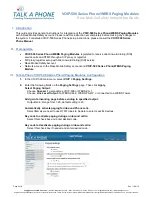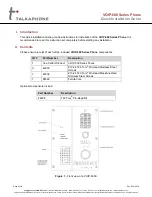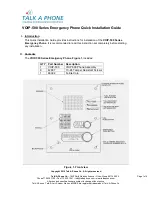
Quality of Service guidelines
312 Avaya Application Solutions IP Telephony Deployment Guide
Note that the 802.1Q tag changes the size and the format of the Ethernet frames. Because of
this, many switches must be explicitly configured to accept 802.1Q tagged frames. Otherwise,
these switches might reject the tagged frames. The two fields to be concerned with are the
Priority and Vlan ID (VID) fields. The Priority field is the “p” in 802.1p/Q, and ranges in value
from 0 to 7. (802.1p/Q is a common term that is used to indicate that the Priority field in the
802.1Q tag has significance. Prior to real-time applications, 802.1Q was used primarily for
VLAN trunking, and the Priority field was not important.) The VID field is used as it always has
been, to indicate the VLAN to which the Ethernet frame belongs.
The IP header with its 8-bit Type of Service (ToS) field, which was, and in some cases still is,
originally used. This original scheme was not widely used, and the IETF developed a new Layer
3 CoS tagging method for IP called Differentiated Services (DiffServ, RFC 2474/2475). DiffServ
uses the first 6 bits of the ToS field, and ranges in value from 0 to 63.
Table 71: Comparison of
DSCP with original TOS
shows the original ToS scheme and DSCP in relation to the 8 bits of the
ToS field.
Ideally, any DSCP value should map directly to a precedence and traffic parameter combination
of the original scheme. This is not always the case, however, and it can cause problems on
some older devices.
On any device, new or old, having a nonzero value in the ToS field cannot hurt if the device is
not configured to examine the ToS field. The problems arise on some legacy devices when the
ToS field is examined, either by default or by enabling QoS. These legacy devices (network and
endpoint) might contain code that only implemented the precedence portion of the original ToS
scheme, with the remaining bits defaulted to zeros. This means that only DSCP values that are
divisible by 8 (XXX000) can map to the original ToS scheme. For example, if an endpoint is
tagging with DSCP 40, a legacy network device can be configured to look for precedence 5,
because both values show up as 10100000 in the ToS field. However, a DSCP of 46 (101110)
cannot be mapped to any precedence value alone. Another snag is if the existing code
implemented precedence with only one traffic parameter permitted to be set high. In this case, a
DSCP of 46 still does not work, because it requires 2 traffic parameter bits to be set high. When
these mismatches occur, the older device mighty reject the DSCP tagged IP packet, or exhibit
some other abnormal behavior. Most newer devices support both DSCP and the original ToS
scheme.
Table 71: Comparison of DSCP with original TOS
8-bit ToS field
IP precedence bits
ToS bits
0
0
1
2
3
4
5
6
7
DSCP bits
0
0
Summary of Contents for Application Solutions
Page 1: ...Avaya Application Solutions IP Telephony Deployment Guide 555 245 600 Issue 3 4 1 June 2005 ...
Page 20: ...About This Book 20 Avaya Application Solutions IP Telephony Deployment Guide ...
Page 21: ...Issue 3 4 1 June 2005 21 Section 1 Avaya Application Solutions product guide ...
Page 22: ...22 Avaya Application Solutions IP Telephony Deployment Guide ...
Page 106: ...Call processing 106 Avaya Application Solutions IP Telephony Deployment Guide ...
Page 124: ...Avaya LAN switching products 124 Avaya Application Solutions IP Telephony Deployment Guide ...
Page 139: ...Issue 3 4 1 June 2005 139 Section 2 Deploying IP Telephony ...
Page 140: ...140 Avaya Application Solutions IP Telephony Deployment Guide ...
Page 186: ...Traffic engineering 186 Avaya Application Solutions IP Telephony Deployment Guide ...
Page 204: ...Security 204 Avaya Application Solutions IP Telephony Deployment Guide ...
Page 228: ...Avaya Integrated Management 228 Avaya Application Solutions IP Telephony Deployment Guide ...
Page 274: ...Reliability and Recovery 274 Avaya Application Solutions IP Telephony Deployment Guide ...
Page 275: ...Issue 3 4 1 June 2005 275 Section 3 Getting the IP network ready for telephony ...
Page 276: ...276 Avaya Application Solutions IP Telephony Deployment Guide ...
Page 356: ...Network recovery 356 Avaya Application Solutions IP Telephony Deployment Guide ...
Page 366: ...Network assessment offer 366 Avaya Application Solutions IP Telephony Deployment Guide ...
Page 367: ...Issue 3 4 1 June 2005 367 Appendixes ...
Page 368: ...Appendixes 368 Avaya Application Solutions IP Telephony Deployment Guide ...
Page 394: ...Access list 394 Avaya Application Solutions IP Telephony Deployment Guide ...
Page 414: ...DHCP TFTP 414 Avaya Application Solutions IP Telephony Deployment Guide ...
















































